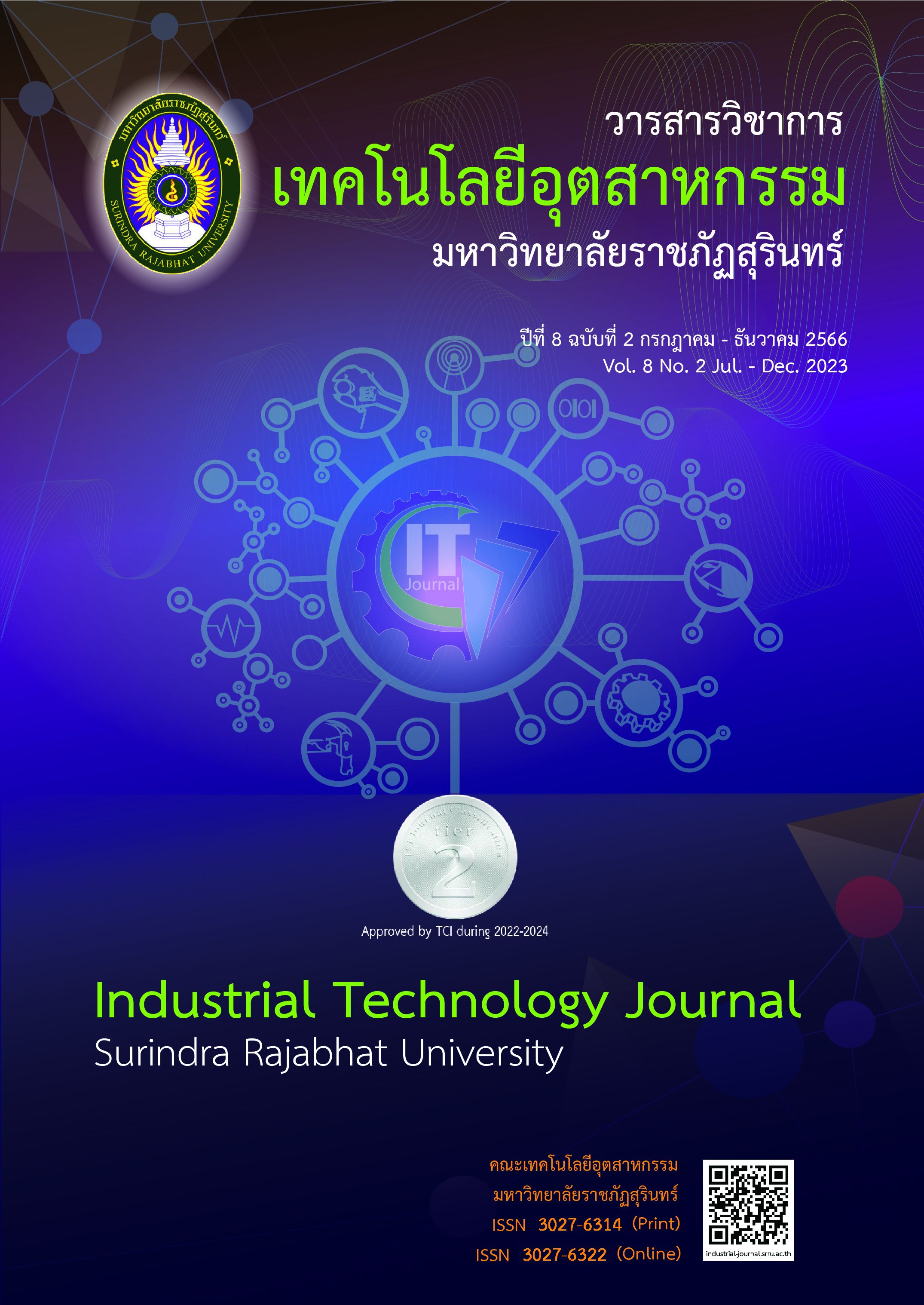การพัฒนาเครื่องบันทึกเพื่อตรวจติดตามอุณหภูมิและความชื้นสัมพัทธ์ ในโรงเลี้ยงไหมพันธุ์พื้นบ้าน
Main Article Content
บทคัดย่อ
การควบคุมอุณหภูมิเพื่อให้สภาพแวดล้อมมีความเหมาะสมหรับการเลี้ยงไหมเป็นปัจจัยที่ส่งผลต่อการเจริญเติบโตของหนอนไหมทุกช่วงวัย ดังนั้นเครื่องมือตรวจวัด บันทึกอุณหภูมิและความชื้นสัมพัทธ์ที่สามารถแสดงผลบนสมาร์ทโฟนจึงเป็นส่วนช่วยให้เกษตรกรผู้เลี้ยงไหมสามารถควบคุมคุณภาพของผลผลิตในราคาไม่สูง โดยมีประสิทธิภาพใกล้เคียงกับเครื่องจากต่างประเทศ โดยมีโครงสร้างการทำงานได้แก่ด้วยโครงสร้างการทำงานที่สำคัญ ได้แก่ ไมโครคอนโทรเลอร์ NodeMCU ESP8266 WiFi ระบบเซ็นเซอร์วัดอุณหภูมิและความชื้นสัมพัทธ์ (DHT11) ระบบจะแสดงผลบน Google Sheet ในงานนี้วิจัยได้ทำการทดลองในโรงเลี้ยงหนอนไหมวัยอ่อน โดยห้องมีขนาด 3 x 4 เมตร โดยมีการกำหนดการทดลองตั้งแต่วันที่ 28 – 30 มกราคม 2566 ผลการทดสอบความแม่นยำและความเที่ยงตรงในการใช้งาน พบว่าในส่วนของอุณหภูมิ หน่วยเป็น °C มีอุณหภูมิ และความชื้นสัมพัทธ์ โดยเปรียบเทียบกับเซนเซอร์ของเครื่องวัดอุณหภูมิและความชื้นของบริษัท NECTEC รุ่น NEB6500 มีเปอร์เซ็นต์ความผิดพลาดเฉลี่ยเท่ากับ 3.93% และในส่วนของความชื้นสัมพัทธ์โดยเฉลี่ย 69.43 RH (Relative Humidiny) มีเปอร์เซ็นต์ความผิดพลาดเฉลี่ยเท่ากับ 1.62% ซึ่งอยู่ในช่วงที่ไม่สูงมากนัก ในด้านต้นทุนโดยประมาณในการพัฒนาเครื่องต้นแบบ เท่ากับ 500 บาท มีราคาต่ำกว่าเซนเซอร์ที่วัดอุณหภูมิและความชื้นที่มีคุณสมบัติใกล้เคียงกัน ประมาณ 94 เปอร์เซ็นต์ ดังนั้น หากนำงานวิจัยนี้ไปต่อยอดในเชิงพาณิชย์จะช่วยลดต้นทุนในการผลิตอุปกรณ์หรือเครื่องมือทางด้านวิทยาศาสตร์และเทคโนโลยีอย่างมากมาย
Article Details
เอกสารอ้างอิง
กรมหม่อนไหม. (2558). คู่มือการปฏิบัติงานด้านหม่อนไหม 52 สัปดาห์, ศูนย์หม่อนไหมเฉลิมพระเกียรติฯ สุรินทร์.
[ออนไลน์]. เข้าถึงได้จาก : https://qsds.go.th/wp- content/uploads/ 2017/pdf/52Week.pdf. สืบค้น : 31 มกราคม 2566 .
คงเดช พะสีนาม และคณะ. (กรกฎาคม-ธันวาคม. 2562). การออกแบบและพัฒนาเครื่องควบคุมอุณหภูมิและ
ความชื้นสัมพัทธ์สำหรับการเพาะต้นอ่อนพืช. วารสารเกษตรนเรศวร. 16 (2) : 27-34.
ณภัชนันท์ ภูมิโคกรักษ์ และคณะ. (2558). ปัจจัยที่มีผลต่อราคาเส้นไหมไทยสาวมือ ใน 4 จังหวัด : นครราชสีมา
บุรีรัมย์ ศรีสะเกษและสุรินทร์ ปี พ.ศ. 2561-2562. [ออนไลน์]. เข้าถึงได้จาก: https://qsds.go.th/newosrd/wp-content/uploads/sites/115/2022/07/silk-2565-7.pdf.
สืบค้น 31 มกราคม 2566.
ธีรยุทธ เสงี่ยมศักดิ์. (2554). “การพัฒนาเครื่องบันทึกเพื่อตรวจติดตามอุณหภูมิและความชื้นสัมพัทธ์ต้นทุนต่ำ
สำหรับงาน สุขศาสตร์อุตสาหกรรมและความปลอดภัย”. วารสารมหาวิทยาลัยนเรศวร. 19 (3) : 1-7.
บุษราภรณ์ ศรีคำนวณ และคณะ. (2557). ระบบตรวจจับอุณหภูมิและความชื้นผ่านแอปพลิเคชันแอนดรอยด์. สาขาวิชาวิศวกรรมไฟฟ้า มหาวิทยาลัยศรีนครินทรวิโรฒ.
พีรศุษม์ ไชยศรีมณีพรรณ และคณะ. (กันยายน-ตุลาคม. 2562). การออกแบบระบบติดตามอุณหภูมิเพื่อเหนี่ยวนำ
การออกดอกของต้นมะยงชิด. วารสารวิทยาศาสตร์และเทคโนโลยี มหาวิทยาลัยมหาสารคาม.
(5) : 520-525.
มานพ แย้มแฟง จักรวาล บุญหวาน ชิโนรส ละอองวรรณ ณัฐกฤช อัสนี รัตนชัย ไพรินทร์ และมนพร คุปตาสา.
(มกราคม - มิถุนายน 2564). การประยุกต์ใช้ระบบการทําความเย็นแบบระเหยร่วมกับระบบ
การทําความเย็นแบบอัดไอมาใช้ในโรงเรือนเลี้ยงไหม. วารสารวิศวกรรมศาสตร์ ราชมงคลธัญบุรี.
(1) : 13-23.
วิจิตตรา คุ้มวงษ์ และสรวง รุ่งประกายพรรณ.(กรกฎาคม-ธันวาคม. 2565). การพัฒนาชุดอุปกรณ์อินเตอร์เน็ต
ของสรรพสิ่งสำหรับติดตามอุณหภูมิและความชื้นของการเก็บรักษายา. วารสารไทยไภษัชยนิพนธ์.
(2) : 101-118.


